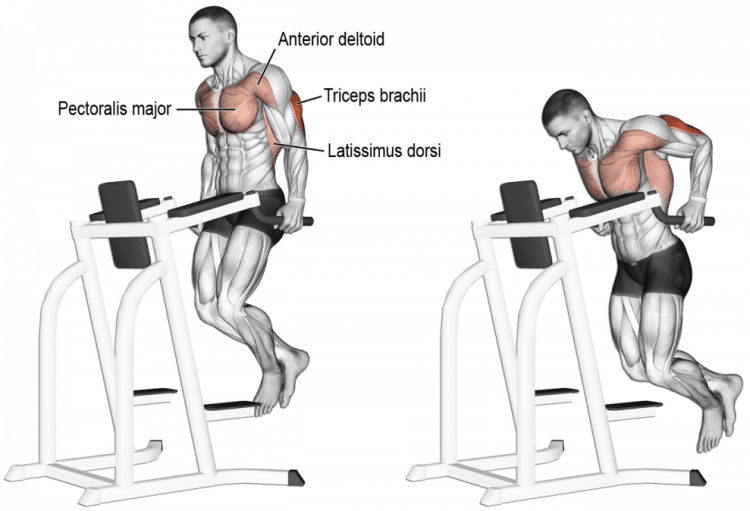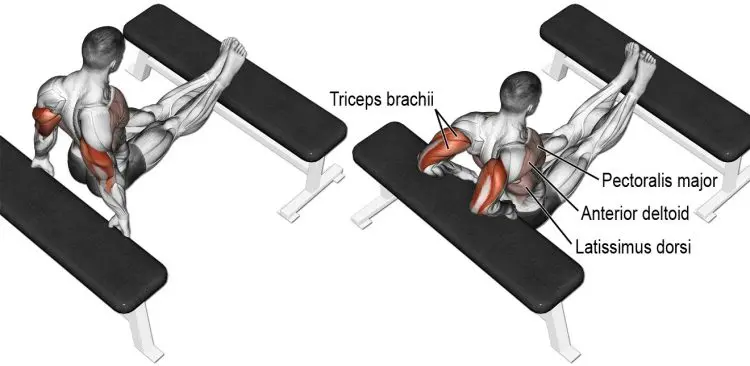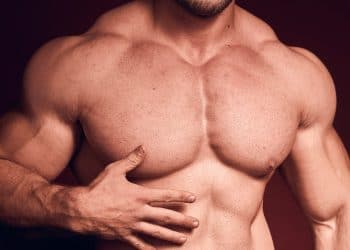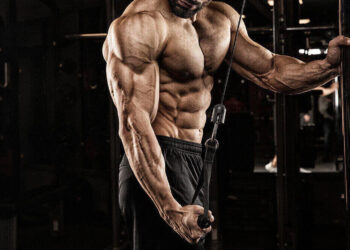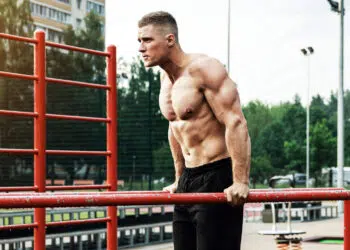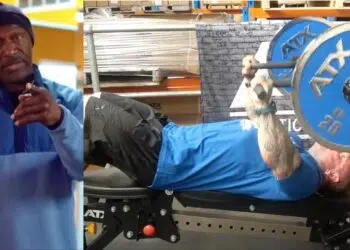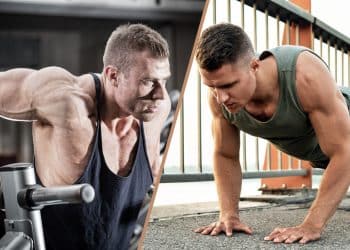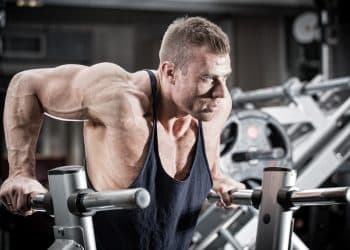Dips are an effective upper body exercise. Using nothing but your body weight for resistance, you can use dips to build muscle, get stronger, and improve your muscular endurance.
However, just small changes in your dip technique will change how this exercise affects your muscles.
In simple terms, that means there are chest dips and triceps dips.
That’s not to say that one type of dip isolates your pecs from your triceps or vice versa. Rather, by modifying your hand position and the angle of your body, you can choose to emphasize your pecs or the back of your arms.
In this article, we explain the difference between chest dips and triceps dips so that you can choose the best one for your goals.
Dip Anatomy

Level Up Your Fitness: Join our 💪 strong community in Fitness Volt Newsletter. Get daily inspiration, expert-backed workouts, nutrition tips, the latest in strength sports, and the support you need to reach your goals. Subscribe for free!
Dips are a compound upper body exercise. That means they involve several joints and muscles working together. While chest and triceps dips emphasize different muscles, both dip variations work the same basic body parts.
The main muscles trained during dips are:
Pectoralis major – known as the pecs for short, this is the large fan-shaped muscle of your upper chest. The pecs can be divided into three sections or heads: upper/clavicular, middle/sternal, and lower/abdominal. Dips emphasize the lower pecs.
Pectoralis minor – this flat, thin muscle lies beneath pec major. It assists the pecs and also helps depress your shoulder girdle.
Deltoids – called the delts for short, these are your shoulder muscles. There are three deltoid heads: anterior/front, medial/middle, and posterior/rear. All three deltoid heads are involved in dips, but the anterior head is most active.
Triceps brachii – located on the back of your upper arm, the triceps extend your elbows during dips. The word triceps means three-headed, while brachial means arm. As such, the triceps is a three-headed arm muscle.
Trapezius – the trapeziusis a large diamond-shaped muscle located on your upper back. There are three sections of fibers: upper, middle, and lower. The mid-traps help hold your shoulders back during dips, while the lower fibers of the trapezius pull and hold your shoulders down. The upper traps are not significantly engaged during dips.
Chest Dips 101
Chest dips are a viable alternative to barbell and dumbbell bench presses, incline presses, and especially decline presses. Chest dips target your lower outer chest.
Like push-ups, you can do dips with just your body weight for resistance.
However, where push-ups load your muscles with about 70-percent of your body weight, dips are closer to 90-percent.
So why not 100-percent for dips? After all, your feet don’t touch the floor.
The reason that you won’t be lifting 100-percent of your body weight is that you’ll be using your arms to generate force and won’t actually be lifting or lowering them.
Because dips are more challenging than push-ups, a) you won’t be able to do as many reps, and b) they’re a helpful progression if you no longer find push-ups sufficiently challenging.
More advanced exercisers can also do chest dips with extra weight to make them harder. There are assisted dip machines that make this exercise easier.
Level Up Your Fitness: Join our 💪 strong community in Fitness Volt Newsletter. Get daily inspiration, expert-backed workouts, nutrition tips, the latest in strength sports, and the support you need to reach your goals. Subscribe for free!
How to Do Chest Dips
- Use dipping bars that are wider than shoulder-width apart. The narrower your grip, the less chest engagement there will be.
- Place your hands on the bars with your palms turned inward. Support your weight on straight arms.
- Bend your knees and push your legs and hips as far back as you can. The greater the incline, the more pec activation there will be.
- Bend your arms and descend as far as you can without hurting your shoulders. Get a good stretch in your pecs. Allow your upper arms and elbows to flare outward.
- Extend your elbows and push yourself upward, stopping just short of lockout to keep the tension on your pecs. Push inward as well as downward to maximize pec engagement.
- Descend and repeat.
A Better Option: The Gironda Chest Dip
Golden-era bodybuilding trainer Vince “The Iron Guru” Gironda had a unique way of doing chest dips, making this exercise even more pec-concentric.
Gironda recommended using handles that were at least 32 inches apart and rounding your lower back so your feet were in front of your shoulders. You should then descend as far as possible to maximize the chest stretch.
Triceps Dips 101
Triceps dips involve your chest less and your triceps more. As such, they’re a good alternative for or supplement to exercises like triceps pushdowns, skull crushers, close grip bench presses, and diamond push-ups.
The main differences between chest and triceps dips is your grip width and the angle of your body.
Note that your pecs are still involved in this dip variation, but they won’t be working as hard as in the chest dip.
How to do triceps dips
- Use dipping bars that are no wider than shoulder-width apart. A wider grip will increase chest activation.
- Place your hands on the bars with your palms turned inward. Support your weight on straight arms.
- Let your legs hang down below you and keep your torso as upright as possible. Some foreword lean is unavoidable and expected, but try to keep it to a minimum.
- Bend your arms and descend until your elbows are bent to around 90-degrees or more. Tuck your arms in and imagine you are pointing your elbows behind you.
- Push yourself upward, extending your arms fully but not quite locking your elbows. Pause here for 1-2 seconds to really challenge your triceps.
- Descend and repeat.
Bench dips
Putting more weight on your triceps may make parallel bar dips too challenging for some exercisers or stop you from doing enough reps to trigger maximum hypertrophy. Because of this, some lifters prefer to do bench dips for their triceps.
To do bench dips…
- Sit on a bench with your feet on the floor. Place your hands on the bench on either side of your hips, fingers pointing forward.
- Lift your butt off the bench and move it slightly forward, so you can descend without touching it.
- Bend your arms and lower your butt toward the floor until your arms are bent to around 90-degrees. Do not descend further, as doing so could cause shoulder pain.
- Push yourself upward, extending your arms fully but not quite locking your elbows. Pause here for 1-2 seconds to really overload your triceps.
- Make this exercise more challenging by extending your legs out in front of you to put more weight on your arms, putting your feet on a bench, or resting a weight plate on your lap.
Chest Dips Vs. Triceps Dips: Which One Is Best?
Chest and triceps dips are very similar, and in some ways, are actually interchangeable, as both involve your chest, triceps, and deltoids.
That said, because they emphasize different muscles, you should use the variation that most closely matches your training goal.
So, if you want to hammer your triceps, narrow grip, upright torso triceps dips as your best option. They’re great sleeve-fillers and will increase triceps strength, too.
But, if you want to train your pecs more than your triceps, chest dips are your best choice. You could even kick things up a notch with Gironda chest dips. Do them as an alternative for or in addition to exercises like bench presses or the chest press machine.
However, be aware that chest dips mostly hit your lower pecs, so it would probably be overkill to do decline bench presses and dips in the same workout.
Can’t decide between these two great exercises? There is nothing to stop you from doing them both. For example, do triceps dips on arm day and chest dips when you train your pecs. That way, you can enjoy all the benefits these exercises have to offer.
Chest Dips Vs. Triceps Dips – Wrapping Up
A lot of people just “do dips” with no real thought about their technique. While any type of dip can be effective, if you are training for a particular goal, it makes sense to choose the dip variation that will deliver the best results.
So, if you want to emphasize your pecs, use a wider than shoulder-width grip, extend your legs behind you, and flare your elbows out to the side.
But, if you want to overload your triceps, adopt a narrower grip, keep your torso upright and your legs below you, and point your elbows to the rear.
However, there is some overlap between dips, and both variations involve your chest, triceps, and shoulders. Adjusting your hand position and the angle of your torso just means you can emphasize either your pecs or triceps.

